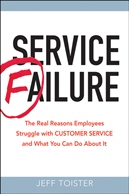Your service is only as good as the weakest link in the chain
 Jeff Toister
Jeff Toister  Tuesday, August 7, 2012 at 9:49AM |
Tuesday, August 7, 2012 at 9:49AM |  A recent post on Micah Solomon’s excellent College of the Customer blog discussed how companies who only pretend to care are doing their customers a disservice. He described a service failure where a hotel sent him a pre-arrival email inviting him to contact the general manager with any special requests, but then failed to deliver when Solomon took them up on their offer. (Read the post here.)
A recent post on Micah Solomon’s excellent College of the Customer blog discussed how companies who only pretend to care are doing their customers a disservice. He described a service failure where a hotel sent him a pre-arrival email inviting him to contact the general manager with any special requests, but then failed to deliver when Solomon took them up on their offer. (Read the post here.)
This type of experience is frustrating, and Solomon makes the point that the offer comes across as disingenuous when it’s not fulfilled. That may be true, but I’d be willing to bet the problem is just as likely the result of a broken service process. According to John Goodman, vice chairman of the noted customer loyalty agency TARP Worldwide, these types of failures are responsible for as much as 60 percent of customer complaints. (See more in Goodman's book, Strategic Customer Service.)
Here are a few examples:
A hotel promises its airport shuttle will arrive every 20 minutes, but it takes an average of 25 minutes to drive the route. The result is the shuttle is usually late. Fail!
A new credit card arrives in the mail. The accompanying letter instructs the cardholder to go to a website for instant activation, but the web address doesn't direct the customer to an activation page. This causes the customer to spend extra time searching the company's website for activation instructions. Fail!
A consultant sends his client a link to an archived webinar, but the client can’t open the link. The result is the client has to send another email to ask the consultant for a working link. Fail! (Okay, this one was me. Soooooooo embarrassing.)
How to eliminate broken processes
There are at least three great ways to prevent service failures that are the result of broken processes.
1. Test
Test things out before sharing them with your customers. Timing the route between the hotel and the airport before writing the shuttle schedule would allow the hotel to determine how long it actually takes. If the hotel realized ahead of time that driving the route took 25 minutes on average, the hotel could revise its schedule or add more shuttles to avoid disappointing guests.
2. Map the touch points
Identify how and where your customer will interact with your company (a.k.a. touch points) and make sure they are all aligned. The credit card company could have mapped their new credit card activation process to ensure the enclosed instructions clearly sent customers to the correct website or optional toll-free number. (See my previous post, Why ALL touch points count.)
3. Act quickly on feedback
There will still be occasions when a customer discovers a process is broken before you do. When that happens, act quickly to fix it. In my case, I had tested out the webinar link ahead of time and it worked fine. When my client reported the problem, I had to do some research to find out why it didn't work for her. As soon as I found the cause, I emailed the corrected the webinar link, apologized for the inconvenience, and thanked my client for bringing it to my attention. I also revisited my webinar software and learned how I had inadvertently caused the problem so I won’t do it again.



